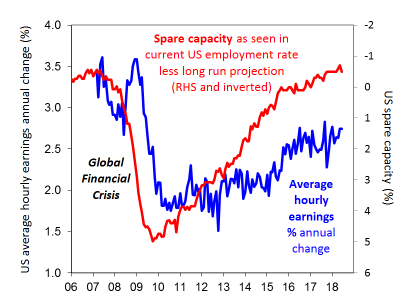11 July 2018
Bob Cunneen, Senior Economist and Portfolio Specialist
US spare capacity vs wages

Sources: Federal Reserve Bank of St. Louis.
The US’s labour market has dramatically improved since the Global Financial Crisis. The unemployment rate has fallen from a peak of 10% in 2009 to currently stand at 4%.
Remarkably US unemployment is now 0.5% below what the US central bank considers to be the long run normal rate of unemployment at 4.5%. Essentially this current -0.5 % spare capacity gap (red line) suggests that the US labour market has run out of available workers to fill job vacancies.
There is some evidence to support this. US business surveys highlight the struggle to fill jobs with suitable applicants. Employers are responding to this challenge using a combination of policies involving more automation, training and even offering higher wages. According to the US Federal Reserve “firms were coping with labour shortages by increasing salaries and benefits in order to attract or retain workers.” Rising US wages as seen in the Average Hourly Earnings growth rate (blue line) support this view.
However the most surprising aspect of the current environment is that US wage increases have been reasonably modest at only 2.7%. In 2007 when the labour market was similarly stretched with limited spare capacity, US wages growth was running at 3.5% annual pace. So why are US workers so cautious in exercising their increased bargaining power to push for higher wages? Essentially we do not know. Perhaps there are many discouraged workers who are sitting on the sidelines, so there is more space capacity than the unemployment rate indicates. Perhaps the painful memory of the GFC is still constraining workers from pushing for higher wages. So the US labour market is a puzzle presently and only time will resolve this conundrum.
Source : Nab assetmanagement 11 July 2018
Important information
This communication is provided by MLC Investments Limited (ABN 30 002 641 661, AFSL 230705) (“MLC”), a member of the National Australia Bank Limited (ABN 12 004 044 937, AFSL 230686) group of companies (“NAB Group”), 105–153 Miller Street, North Sydney 2060. An investment with MLC does not represent a deposit or liability of, and is not guaranteed by, the NAB Group. The information in this communication may constitute general advice. It has been prepared without taking account of individual objectives, financial situation or needs and because of that you should, before acting on the advice, consider the appropriateness of the advice having regard to your personal objectives, financial situation and needs. MLC believes that the information contained in this communication is correct and that any estimates, opinions, conclusions or recommendations are reasonably held or made as at the time of compilation. However, no warranty is made as to the accuracy or reliability of this information (which may change without notice). MLC relies on third parties to provide certain information and is not responsible for its accuracy, nor is MLC liable for any loss arising from a person relying on information provided by third parties. Past performance is not a reliable indicator of future performance. This information is directed to and prepared for Australian residents only. MLC may use the services of NAB Group companies where it makes good business sense to do so and will benefit customers. Amounts paid for these services are always negotiated on an arm’s length basis.


